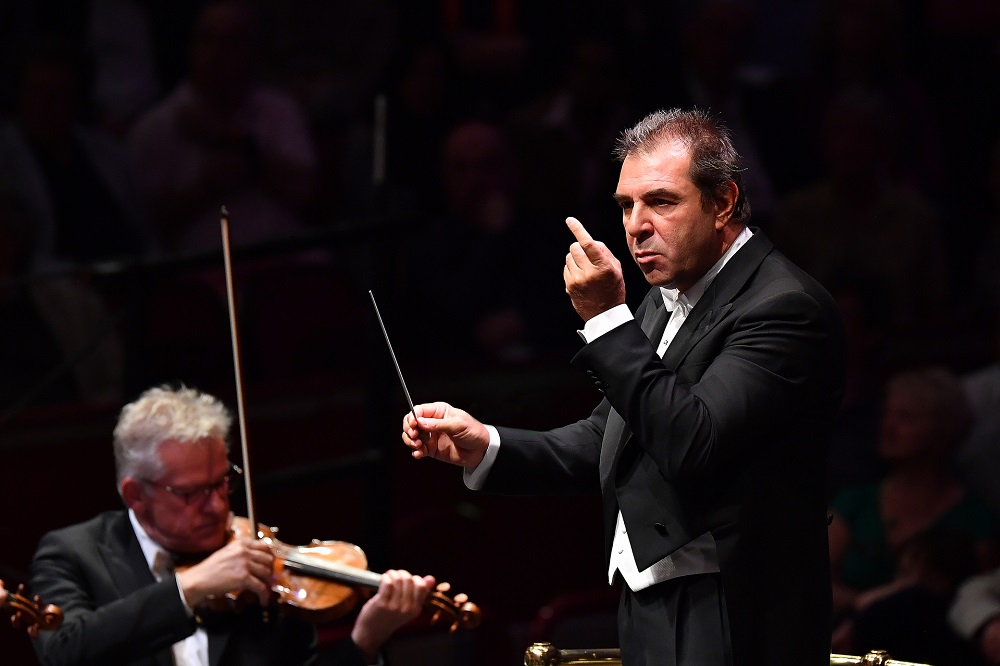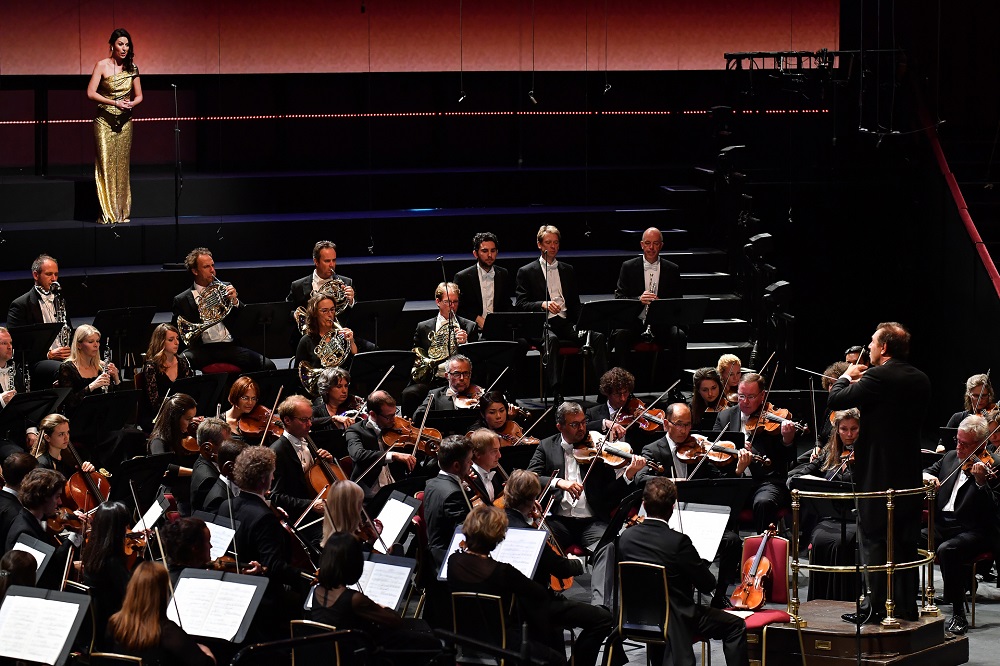Proms 64 & 66 review: Royal Concertgebouw Orchestra, Gatti - halfway to paradise with Bruckner and Mahler | reviews, news & interviews
Proms 64 & 66 review: Royal Concertgebouw Orchestra, Gatti - halfway to paradise with Bruckner and Mahler
Proms 64 & 66 review: Royal Concertgebouw Orchestra, Gatti - halfway to paradise with Bruckner and Mahler
Amsterdam's finest falter on the way to heaven, but get there in the end
How do you get to heaven, especially if you need to reach the pearly gates by way of the earthbound acoustics of the Royal Albert Hall? With Chief Conductor Daniele Gatti as their spirit guide, the sumptuously arrayed pilgrim band of the Royal Concertbegouw Orchestra from Amsterdam sought different routes in the centrepieces of their pair of Proms.
For their first outing, the Concertgebouw prefaced their Bruckner with In-Schrift by the fearsomely productive Wolfgang Rihm. Written in 1995 for the basilica of St Mark’s in Venice, this compact but epic battle between separated groups of instruments begins with an ecclesiastical F sharp clang of five tubular bells from the percussion rank. Below them sit a phalanx of brass, with more horns, cellos and basses in the second row, then woodwind and harp in the front-line. Violins and violas are absent, with leave. If this sounds more military than liturgical, then Rihm’s punchy volleys of sound – as much Stravinsky, who also wrote for St Mark’s, as Gabrieli – make a big, impressively marshalled push to fill an echoing space. The aftermaths of these striking salvos reverberate long and hard. In this hall, the strategy worked well, all the way from ultra-deep bass trombones somewhere in the catacombs to bird-like flutes fluttering up in the eaves. Percussion-driven heartbeats hinted at combat trauma as much as sacred awe. Bongos and woodblocks set up a bat-like chatter while the swaggering heavy brass, in the ascendent all evening, strove to burst into the relief of some full-dress, Wagner-like funeral music. But they always found some interruption in the way.
On Saturday, the Amsterdamers led out Haydn’s Symphony No. 82 – the “Bear” – as a warm-up act for Mahler’s Fourth. Unwise? The Parisians for whom Haydn wrote it thought that the Vivace finale, with its bagpipe-like drone and folksy woodwind on the top, brought to mind music to make a chained beast dance. Well, the orchestra (slimmed down to classical dimensions) sounded a little like some tethered wild thing itself: sleek, hefty but restrained, slightly absent in heart if not in gesture. Could they be just too refined for this sophisticated rusticity, its plain, melodic C major honesty always so artfully complicated without any loss of basic innocence? Haydn in this guise can resemble Queen Marie Antoinette decked out as a shepherdess, and it takes a rare flair to keep up the charade. 
Mahler’s insistence on swinging, relaxed, unhurried tempi meant that Gatti could allow his all-star cast of instrumentalists to shine. Especially in the divine wood-and-brass chit-chat of the scherzo, each voice felt fresh, firm, thoroughly assured and sometimes even cheeky, from the flutes led by Kersten McCall to the oboes (Alexei Ogrintchouk) and the horns (Laurens Woudenberg and friends). By the third movement, the concluding starburst of E major bliss drove all doubts away with a thrilling radiance. Then, behind and above the band, Chen Reiss (pictured above aloft) sang of the child’s heaven with a sweet strength that never cloyed. Mahler and mischief are never too far apart, and she rightly went for sassiness, not schmaltz. For some sopranos, the obligation to sing from behind the Concertgebouw might imply a season in hell rather than paradise. Not here: ethereal but still grounded, Reiss wafted us up into the clouds with an angelic – but never sentimental – touch.
rating
Share this article
Add comment
The future of Arts Journalism
You can stop theartsdesk.com closing!
We urgently need financing to survive. Our fundraising drive has thus far raised £49,000 but we need to reach £100,000 or we will be forced to close. Please contribute here: https://gofund.me/c3f6033d
And if you can forward this information to anyone who might assist, we’d be grateful.

Subscribe to theartsdesk.com
Thank you for continuing to read our work on theartsdesk.com. For unlimited access to every article in its entirety, including our archive of more than 15,000 pieces, we're asking for £5 per month or £40 per year. We feel it's a very good deal, and hope you do too.
To take a subscription now simply click here.
And if you're looking for that extra gift for a friend or family member, why not treat them to a theartsdesk.com gift subscription?
more Classical music
 Goldscheider, Brother Tree Sound, Kings Place review - music of hope from a young composer
Unusual combination of horn, strings and electronics makes for some intriguing listening
Goldscheider, Brother Tree Sound, Kings Place review - music of hope from a young composer
Unusual combination of horn, strings and electronics makes for some intriguing listening
 theartsdesk Q&A: composer Donghoon Shin on his new concerto for pianist Seong-Jin Cho
Classical music makes its debut at London's K-Music Festival
theartsdesk Q&A: composer Donghoon Shin on his new concerto for pianist Seong-Jin Cho
Classical music makes its debut at London's K-Music Festival
 Helleur-Simcock, Hallé, Wong, Bridgewater Hall, Manchester review - moving lyricism in Elgar’s concerto
Season opener brings lyrical beauty, crisp confidence and a proper Romantic wallow
Helleur-Simcock, Hallé, Wong, Bridgewater Hall, Manchester review - moving lyricism in Elgar’s concerto
Season opener brings lyrical beauty, crisp confidence and a proper Romantic wallow
 Kohout, Spence, Braun, Manchester Camerata, Huth, RNCM, Manchester review - joy, insight, imagination and unanimity
Celebration of the past with stars of the future at the Royal Northern College
Kohout, Spence, Braun, Manchester Camerata, Huth, RNCM, Manchester review - joy, insight, imagination and unanimity
Celebration of the past with stars of the future at the Royal Northern College
 Jansen, LSO, Pappano, Barbican review - profound and bracing emotional workouts
Great soloist, conductor and orchestra take Britten and Shostakovich to the edge
Jansen, LSO, Pappano, Barbican review - profound and bracing emotional workouts
Great soloist, conductor and orchestra take Britten and Shostakovich to the edge
 Jakub Hrůša and Friends in Concert, Royal Opera review - fleshcreep in two uneven halves
Bartók kept short, and a sprawling Dvořák choral ballad done as well as it could be
Jakub Hrůša and Friends in Concert, Royal Opera review - fleshcreep in two uneven halves
Bartók kept short, and a sprawling Dvořák choral ballad done as well as it could be
 Hadelich, BBC Philharmonic, Storgårds, Bridgewater Hall, Manchester review - youth, fate and pain
Prokofiev in the hands of a fine violinist has surely never sounded better
Hadelich, BBC Philharmonic, Storgårds, Bridgewater Hall, Manchester review - youth, fate and pain
Prokofiev in the hands of a fine violinist has surely never sounded better
 Monteverdi Choir, ORR, Heras-Casado, St Martin-in-the-Fields review - flames of joy and sorrow
First-rate soloists, choir and orchestra unite in a blazing Mozart Requiem
Monteverdi Choir, ORR, Heras-Casado, St Martin-in-the-Fields review - flames of joy and sorrow
First-rate soloists, choir and orchestra unite in a blazing Mozart Requiem
 Cho, LSO, Pappano, Barbican review - finely-focused stormy weather
Chameleonic Seong-Jin Cho is a match for the fine-tuning of the LSO’s Chief Conductor
Cho, LSO, Pappano, Barbican review - finely-focused stormy weather
Chameleonic Seong-Jin Cho is a match for the fine-tuning of the LSO’s Chief Conductor
 Classical CDs: Shrouds, silhouettes and superstition
Cello concertos, choral collections and a stunning tribute to a contemporary giant
Classical CDs: Shrouds, silhouettes and superstition
Cello concertos, choral collections and a stunning tribute to a contemporary giant
 Appl, Levickis, Wigmore Hall review - fun to the fore in cabaret and show songs
A relaxed evening of light-hearted fare, with the accordion offering unusual colours
Appl, Levickis, Wigmore Hall review - fun to the fore in cabaret and show songs
A relaxed evening of light-hearted fare, with the accordion offering unusual colours
 Lammermuir Festival 2025, Part 2 review - from the soaringly sublime to the zoologically ridiculous
Bigger than ever, and the quality remains astonishingly high
Lammermuir Festival 2025, Part 2 review - from the soaringly sublime to the zoologically ridiculous
Bigger than ever, and the quality remains astonishingly high

Comments
Emily Beynon wasn't playing
Thanks, updated now. Both
Thanks, updated now. Both principals equally fine. BT